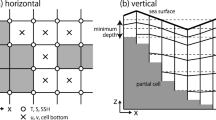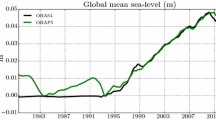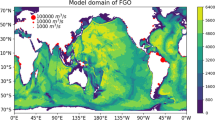Abstract
We developed a new system to monitor and forecast coastal and open-ocean states around Japan for operational use by the Japan Meteorological Agency. The system consists of an eddy-resolving analysis model based on four-dimensional variational assimilation and a high (2-km) resolution forecast model covering Japanese coastal areas that incorporates an initialization scheme with temporal and spatial filtering. Assimilation and forecast experiments were performed for 2008 to 2017, and the results were validated against various observation datasets. The assimilation results captured well the observed variability in sea surface temperature, coastal sea level, volume transport, and sea ice. Furthermore, the volume budget for the Japan Sea was significantly improved by the use of the 2-km resolution forecast model compared with the 10-km resolution analysis model. The forecast results indicate that this system has a predictive limit longer than 1 month in many areas, including in the Kuroshio current area south of Japan and the southern Japan Sea. In the forecast results of case studies, the 2017 Kuroshio large meander was well predicted, and warm water intrusions accompanying Kuroshio path variations south of Japan were also successfully reproduced. Sea ice forecasts for the Sea of Okhotsk largely captured the evolution of sea ice in late winter, but sea ice in early winter included relatively large errors. This system has high potential to meet operational requirements for monitoring and forecasting ocean phenomena at both meso- and coastal scales.





















Similar content being viewed by others
References
Bloom SC, Takacs LL, Silva AMD, Ledvina D (1996) Data assimilation using incremental analysis updates. Mon Weather Rev 124:1256–1271
Boyer TP, Antonov JI, Baranova OK, Coleman C, Garcia HE, Grodsky A, Johnson DR, Locarnini RA, Mishonov AV, O'Brien TD, Paver CR, Reagan JR, Seidov D, Smolyar IV, Zweng MM (2013) World ocean database 2013. NOAA Atlas NESDIS 72
Fujii Y (2005) Preconditioned optimizing utility for large-dimensional analyses (POpULar). J Oceanogr 61:167–181
Fujii Y, Kamachi M (2003) Three-dimensional analysis of temperature and salinity in the Equatorial Pacific using a variational method with vertical coupled temperature-salinity EOF modes. J Geophys Res 108:3297. https://doi.org/10.1029/2002JC001745
Fujii Y, Ishizaki S, Kamachi M (2005) Application of nonlinear constraints in a three-dimensional variational ocean analysis. J Oceanogr 61:655–662
Fujii S, Heron ML, Kim K, Lai JW, Lee SH, Wu X, Wu X, Wyatt LR, Yang WC (2013) An overview of developments and applications of oceanographic radar networks in Asia and Oceania countries. Ocean Sci J 48(1):69–97
Fujisaki A, Yamaguchi H, Duan F, Sagawa G (2007) Improvement of short-term sea ice forecast in the southern Okhotsk Sea. J Oceanogr 63(5):775–790. https://doi.org/10.1007/s10872-007-0066-x
Fukudome KI, Yoon JH, Ostrovskii A, Takikawa T, Han IS (2010) Seasonal volume transport variation in the Tsushima warm current through the Tsushima Straits from 10 years of ADCP observations. J Oceanogr 66(4):539–551
Hamilton D (1994) GTSPP builds an ocean temperature-salinity database. Earth Syst Monitor 4:4–5
Han S, Hirose N, Usui N, Miyazawa Y (2016) Multi-model ensemble estimation of volume transport through the straits of the East/Japan sea. Ocean Dyn 66(1):59–76. https://doi.org/10.1007/s10236-015-0896-9
Han S, Hirose N, Kida S (2018) The role of topographically induced form drag on the channel flows through the East/Japan Sea. J Geophys Res: Oceans 123:6091–6105. https://doi.org/10.1029/2018JC013903
Hinata H, Yanagi T, Takano T, Kawamura H (2005) Wind-induced Kuroshio warm water intrusion into Sagami Bay. J Geophys Res 110(C3):C03023. https://doi.org/10.1029/2004JC002300
Hunke EC, Dukowicz JK (1997) An elastic-viscous-plastic model for sea ice dynamics. J Phys Oceanogr 27:1849–1867. https://doi.org/10.1175/1520-0485(1997)027<1849:AEVPMF>2.0.CO;2
Hunke EC, Dukowicz JK (2002) The elastic-viscous-plastic sea ice dynamics model in general orthogonal curvilinear coordinates on a sphere: incorporation of metric terms. Mon Weather Rev 130:1848–1865. https://doi.org/10.1175/1520-0493(2002)130<1848:TEVPSI>2.0.CO;2
IPCC (2014) Climate change 2014: synthesis report. Contribution of working groups I, II and III to the fifth assessment report of the Intergovernmental Panel on Climate Change [Core Writing Team, R.K. Pachauri and L.A. Meyer (eds.)]. IPCC, Geneva, Switzerland, 151 pp
Isobe A, Guo X, Takeoka H (2010) Hindcast and predictability of sporadic Kuroshio-water intrusion (Kyucho in the Bungo Channel) into the shelf and coastal waters. J Geophys Res 115:C04,023. https://doi.org/10.1029/2009JC005818
Isobe A, Kako S, Guo X, Takeoka H (2012) Ensemble numerical forecasts of the sporadic Kuroshio water intrusion (Kyucho) into shelf and coastal waters. Ocean Dyn 62(4):633–644
Ito T, Togawa O, Ohnishi M, Isoda Y, Nakayama T, Shima S, Kuroda H, Iwahashi M, Sato C (2003) Variation of velocity of volume transport of the Tsugaru warm current in the winters of 1999-2000. Geophys Res Lett 30:1678
Kamachi M, Kuragano T, Sugimoto S, Yoshita K, Sakurai T, Nakano T, Usui N, Uboldi F (2004) Short-range prediction experiments with operational data assimilation system for the Kuroshio south of Japan. J Oceanogr 60:269–282
Katusumata T (2016) Generation of periodic intrusions at Suruga Bay when the Kuroshio follows a large meandering path. Cont Shelf Res 123:9–17. https://doi.org/10.1016/j.csr.2016.04.005
Kawabe M (1980) Sea level variations along the south coast of Japan and the large meander in the Kuroshio. J Oceanogr Soc Jpn 36:97–104
Kawabe M (1987) Spectral properties of sea level and time scale of Kuroshio path variations. J Oceanogr Soc Jpn 43:111–123
Kawabe M (1995) Variations of current path, velocity, and volume transport of the Kuroshio in relation with the large meander. J Phys Oceanogr 25:3103–3117
Komori N, Awaji T, Ishikawa Y, Kuragano T (2003) Short-range forecast experiments of the Kuroshio path variabilities south of Japan using TOPEX/Poseidon altimetric data. J Geophys Res 108(C1:3010. https://doi.org/10.1029/2001JC001282
Kuragano T, Kamachi M (2000) Global statistical space-time scales of oceanic variability estimated from the TOPEX/POSEIDON altimetry data. J Geophys Res 105:955–974
Kurihara Y, Sakurai T, Kuragano T (2006) Global daily sea surface temperature analysis using data from satellite microwave radiometer, satellite infrared radiometer and in-situ observations. Weather Bull 73:s1–s18 (in Japanese)
Kurihara Y, Murakami H, Kachi M (2016) Sea surface temperature from the new Japanese geostationary meteorological Himawari-8 satellite. Geophys Res Lett 43:1234–1240. https://doi.org/10.1002/2015GL067159
Kuroda H, Setou T, Aoki K, Takahashi D, Shimizu M, Watanabe T (2013) A numerical study of the Kuroshio-induced circulation in Tosa Bay, off the southern coast of Japan. Cont Shelf Res 53:50–62. https://doi.org/10.1016/j.csr.2012.12.005
Kuroda H, Setou T, Kakehi S, Ito S, Taneda T, Azumaya T, Inagake D, Hiroe Y, Morinaga K, Okazaki M, Yokota T, Okunishi T, Aoki K, Shimizu Y, Hasegawa D, Watanabe T (2017) Recent advances in Japanese fisheries science in the Kuroshio-Oyashio region through development of the FRA-ROMS ocean forecast system: overview of the reproducibility of reanalysis products. Open J Mar Sci 7:62–90. https://doi.org/10.4236/ojms.2017.71006
Kuroda H, Takasuka A, Hirota Y, Kodama T, Ichikawa T, Takahashi D, Aoki K, Setou T (2018) Numerical experiments based on a coupled physical–biochemical ocean model to study the Kuroshio-induced nutrient supply on the shelf-slope region off the southwestern coast of Japan. J Mar Syst 179:38–54. https://doi.org/10.1016/j.jmarsys.2017.11.002
Leonard BP (1979) A stable and accurate convective modeling procedure based upon quadratic upstream interpolation. J Comput Methods Appl Mech Eng 19:59–98. https://doi.org/10.1016/0045-7825(79)90034-3
Locarnini RA, Mishonov AV, Antonov JI, Boyer TP, Garcia HE, Baranova OK, Zweng MM, Paver CR, Reagan JR, Johnson DR, Hamilton M, Seidov D (2013) World ocean atlas 2013, volume 1: temperature. NOAA atlas NESDIS 73
Mellor GL, Kantha L (1989) An ice-ocean coupled model. J Geophys Res 94:10937–10954. https://doi.org/10.1029/JC094iC08p10937
Mertz, F, Pujol MI, Faugère Y, (2018). Product user manual (CMEMS-SL-PUM-008-032-051). cmems-resources.cls.fr, version 4.0
Miyazawa Y, Zhang T, Guo X, Tamura H, Ambe D, Lee JS, Okuno A, Yoshinari H, Setou T, Komatsu K (2009) Water mass variability in the western North Pacific detected in a 15-year eddy resolving ocean reanalysis. J Oceanogr 65:737–756
Murphy AH (1988) Skill scores based on the mean squared error and their relationships to the correlation coefficient. Mon Weather Rev 116:2417–2424
Nishida Y, Kanomata I, Tanaka I, Sato S, Takahashi S, Matsubara H (2003) Seasonal and interannual variations of the volume transport through the Tsugaru strait. Umi no kenkyu 12:487{499 (in Japanese with English abstract)
Ohshima KI, Simizu D, Ebuchi N, Morishima S, Kashiwase H (2017) Volume, heat, and salt transports through the soya strait and their seasonal and interannual variations. J Phys Oceanogr 47(5):999–1019. https://doi.org/10.1175/JPO-D-16-0210.1
Prather MJ (1986) Numerical advection by conservation of second-order moments. J Geophys Res 91(D6):6671–6681. https://doi.org/10.1029/JD091iD06p06671
Qiu B, Chen S (2010) Interannual variability of the North Pacific subtropical countercurrent and its associated mesoscale eddy field. J Phys Oceanogr 40:213–225. https://doi.org/10.1175/2009JPO4285.1
Ramp SV, Barrick DE, Ito T, Cook MS (2008) Variability of the Kuroshio current south of Sagami Bay as observed using long-range coastal HF radars. J Geophys Res 110(C3):C06024. https://doi.org/10.1029/2007JC004132
Sakamoto K, Tsujino H, Nakano H, Hirabara M, Yamanaka G (2013) A practical scheme to introduce explicit tidal forcing into an OGCM. Ocean Sci 9:1089–1108. https://doi.org/10.5194/os-9-1089-2013
Sakamoto K, Yamanaka G, Tsujino H, Nakano H, Urakawa S, Usui N, Hirabara M, Ogawa K (2016) Development of an operational coastal model of the Seto Inland Sea, Japan. Ocean Dyn 66(1):77–97. https://doi.org/10.1007/s10236-015-0908-9
Sakamoto K, Tsujino H, Nakano H, Urakawa LS, Toyoda T, Hirose N, Usui N, Yamanaka G (2019) Development of a 2km-resolution ocean model covering the coastal seas around Japan for operational application. Ocean Dyn in press. https://doi.org/10.1007/s10236-019-01291-1
Simizu D, Ohshima KI, Ono J, Fukamachi Y, Mizuta G (2014) What drives the southward drift of sea ice in the Sea of Okhotsk? Prog Oceanogr 126:33–43. https://doi.org/10.1016/j.pocean.2014.05.013
Suzuki T, Yamazaki D, Tsujino H, Komuro Y, Nakano H, Urakawa S (2017) A dataset of continental river discharge based on JRA-55 for use in a global ocean circulation model. J Oceanogr 74:421–429. https://doi.org/10.1007/s10872-017-0458-5
Takahashi D, Morimoto A, Nakamura T, Hosaka T, Mino Y, Dang VH, Saino T (2012) Short-term flow and water temperature fluctuations in Sagami Bay, Japan, associated with variations of the Kuroshio during the non-large-meander path. Prog Oceanogr 105:47–60. https://doi.org/10.1016/j.pocean.2012.04.012
Toba Y, Tomizawa K, Kurasawa Y, Hanawa K (1982) Seasonal and year-to-year variability of the Tsushima Tsugaru warm current system with its possible cause. La Mer 20:41–51
Tsujino H, Nakano H, Sakamoto K, Urakawa S, Hirabara M, Ishizaki H, Yamanaka G (2017) Reference manual for the Meteorological Research Institute Community Ocean Model version 4 (MRI.COMv4). Tech Rep. 80. Meteorological Research Institute, Japan. https://doi.org/10.11483/mritechrepo./80
Tsujino H, Urakawa S, Nakano H, Small RJ, Kim WM, Yeager SG, Danabasoglu G, Suzuki T, Bamber JL, Bentsen M, Böning CW, Bozec A, Chassignet EP, Curchitser E, Dias FB, Durack PJ, Griffies SM, Harada Y, Ilicak M, Josey SA, Kobayashi C, Kobayashi S, Komuro Y, Large WG, Sommer JL, Marsland SJ, Masina S, Scheinert M, Tomita H, Valdivieso M, Yamazaki D (2018) JRA-55 based surface dataset for driving ocean-sea-ice models (JRA55-do). Ocean Modell 130:79–139. https://doi.org/10.1016/j.ocemod.2018.07.002
Urakawa LS, Yamanaka G, Hirabara M, Sakamoto K, Tsujino H, Nakano H (2016) Assessment of the usefulness of JMA runoff index in coastal ocean modeling around Japan. Weather Bull 83:s33–s45 (in Japanese), http://www.jma.go.jp/jma/kishou/books/sokkou-kaiyou/83/vol83s033.pdf. Accessed 28 Dec 2018
Usui N, Ishizaki S, Fujii Y, Tsujino H, Yasuda T, Kamachi M (2006a) Meteorological Research Institute multivariate ocean variational estimation (MOVE) system: some early results. Adv Space Res 37:806–822. https://doi.org/10.1016/j.asr.2005.09.022
Usui N, Tsujino H, Fujii Y, Kamachi M (2006b) Short-range prediction experiments of the Kuroshio path variabilities south of Japan. Ocean Dyn 56:607–623
Usui N, Imaizumi T, Tsujino H (2010) Toward introduction of assimilation of ice concentration into move/mri.com: a model validation and a simple assimilation experiment in the sea of Okhotsk. Weather Bull 77:s72–s82 (in Japanese), http://www.jma.go.jp/jma/kishou/books/sokkou-kaiyou/77/vol77s071.pdf. Accessed 28 Dec 2018
Usui N, Ishizaki S, Fujii Y, Kamachi M (2011) Improving strategies with constraints regarding non-Gaussian statistics in a three-dimensional variational assimilation method. J Oceanogr 67:253–262
Usui N, Fujii Y, Sakamoto K, Kamachi M (2015) Development of a four-dimensional variational assimilation system toward coastal data assimilation around Japan. Mon Weather Rev 143:3874–3892. https://doi.org/10.1175/MWR-D-14-00326.1
Usui N, Wakamatsu T, Tanaka Y, Hirose N, Toyoda T, Nishikawa S, Fujii Y, Takatsuki Y, Igarashi H, Nishikawa H, Ishikawa Y, Kuragano T, Kamachi M (2017) Four-dimensional variational ocean reanalysis: a 30-year high-resolution dataset in the western North Pacific (FORA-WNP30). J Oceanogr 73:205–233. https://doi.org/10.1007/s10872-016-0398-5
Varlamov SM, Guo X, Miyama T, Ichikawa K, Waseda T, Miyazawa Y (2015) M2 baroclinic tide variability modulated by the ocean circulation south of Japan. J Geophys Res Oceans 120(5):3681–3710. https://doi.org/10.1002/2015JC010739
Watanabe T, Ikeda M, Wakatsuchi M (2004) Thermohaline effects of the seasonal sea ice cover in the sea of Okhotsk. J Geophys Res 109(C9):C09S02. https://doi.org/10.1029/2003JC001905
Zweng MM, Reagan JR, Antonov JI, Locarnini RA, Mishonov AV, Boyer TP, Garcia HE, Baranova OK, Johnson DR, DSeidov, Biddle MM (2013) World ocean atlas 2013, volume 2: salinity. NOAA Atlas NESDIS 74
Acknowledgments
We thank the members of the Global Environment and Marine Department of Japan Meteorological Agency for fruitful discussions and helpful comments. Thanks are extended to two anonymous reviewers for their variable comments that greatly helped improve an early version of the manuscript. In situ temperature and salinity profiles were obtained from the World Ocean Database (WOD: ftp://ftp.nodc.noaa.gov/pub/WOD/) and the Global Temperature-Salinity Profile Program (GTSPP: ftp://ftp.nodc.noaa.gov/pub/data.nodc/gtspp) websites. The delayed-mode altimeter products were produced and distributed by the Archiving, Validation and Interpretation of Satellite Oceanographic data (AVISO) and the Copernicus Marine and Environment Monitoring Service (CMEMS). The tide gauge data, Merged Satellite and In situ Data Global Daily SST (MGDSST), Himawari-SST, near-real-time altimeter datasets, and in situ temperature and salinity profiles obtained operationally were provided from the Japan Meteorological Agency (JMA). Sea level pressure data was obtained from the JMA’s website. The station temperature data is acquired from acquired from the real-time marine information acquisition and analysis system operated by Japan Fisheries Research and Education Agency and the Online Water Quality Monitoring System in Osaka Bay.
Funding
This work was funded by Meteorological Research Institute. This study was partly supported by JSPS KAKENHI Grant Numbers 16H02226 and 19K03978, Research Program on Core Research for Evolutional Science and Technology (CREST JPMJCR1681) of MEXT, and the Joint Research Program of the Institute of Low Temperature Science, Hokkaido University (18S0002 and 19S0003).
Author information
Authors and Affiliations
Corresponding author
Additional information
Responsible Editor: Emil Vassilev Stanev
This article is part of the Topical Collection on Coastal Ocean Forecasting Science supported by the GODAE OceanView Coastal Oceans and Shelf Seas Task Team (COSS-TT) - Part II
Appendix: Abbreviations
Appendix: Abbreviations
Abbreviations used frequently in this paper are summarized as follows:
- AVISO:
Archiving, Validation and Interpretation of Satellite Oceanographic data
- CMEMS:
Copernicus Marine and Environment Monitoring Service
- IAU:
Increment analysis updates
- IB:
Inverted barometer
- JMA:
Japan Meteorological Agency
- KLM:
Kuroshio large meander
- MGDSST:
Merged satellite and in situ global daily sea surface temperature
- MRI:
Meteorological Research Institute
- nNLM:
Nearshore nonlarge meander path
- oNLM:
Offshore nonlarge meander path
- SDH:
Surface dynamic height
- SIC:
Sea ice concentration
- SLA:
Sea level anomaly
- SLD:
Sea level difference
- SSH:
Sea surface height
- SST:
Sea surface temperature
- tLM:
Typical large meander path
- T–S:
Temperature and salinity
Rights and permissions
About this article
Cite this article
Hirose, N., Usui, N., Sakamoto, K. et al. Development of a new operational system for monitoring and forecasting coastal and open-ocean states around Japan. Ocean Dynamics 69, 1333–1357 (2019). https://doi.org/10.1007/s10236-019-01306-x
Received:
Accepted:
Published:
Issue Date:
DOI: https://doi.org/10.1007/s10236-019-01306-x




